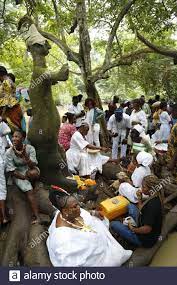“I have come here with faith and belief and I will make a wish and my wish will be granted. By this time next year, my life won’t be the same. So, I am glad to be here.’’
This was how Jamiu Adegbite, a student, captured his mission to the Osun grove on Friday, August 14, while participating in the 2021 pilgrimage to mark the famous Osun-Osogbo Festival.
He adorned a neatly sown white lace and held a white pigeon by the bank of the Osun River, facing Yeye Osun, the statue depicting the river goddess, with outstretched hands welcoming guests and devotees.
Adegbite sat on a tree trunk with some youths, each holding a white bird, all facing the goddess, which stature was covered to almost its knee by the flowing river in the grove, for which many devotees descended the valley to fetch.
The water was creamy; however, every devotee fetched it due to the belief in its spirituality and efficacy in curing all kinds of illnesses, satisfying other physical, spiritual, and material needs of those who made wishes in the grove.
“Today is a special day for me, sure. Coming here means happiness and fun. You will be able to see a lot of things. This is tradition and it has been going on for a long. It is a thing of joy for me to be here today. I am happy to be here and this is my first day.
“I expect a lot of good things because I was told that whenever you come here you will make a wish and your wish shall be granted,’’ Adegbite said.
The 2021 Osun-Osogbo cultural festival is held in the week, with some rites performed by the devotees in the grove and the ancestral homes of Osogbo people up to the palace of the traditional ruler of the ancient town.
However, everyone looked forward to the procession day of the Arugba, the female calabash bearer, from the Kabiyesi’s palace to the shrine where the Arugba would deposit the calabash.
The calabash is believed to have warehoused all the problems of the traditional worshippers in the preceding year for the attention of the god.
Prominent among them is the issue of infertility among women, then possession by evil spirits causing disharmony in relationships, lack of business progress, spiritual attacks, and so on.
As early as 5.00 am that fateful day, bells were tolling in all parts of Osun with the devotees, mostly clad in all white apparels, heading toward the riverside.
A tarred trunk “A” road descended the slope to the ancient Osogbo town. By the cosmopolitan nature of the town, now the capital of Osun, created in 1991, the road is flanked by residential houses, a school, a petrol station, and sundry business premises.
Crowds of people were seen descending and ascending the slope, simultaneously, in no particular order, but most of the time in zigzags.
Adults, children, motorcycle riders, beggars, and even cabs struggled up and down the slope without interference or molestation from security agents, except when the Arugba, with a retinue of priests and priestesses, made their way toward the grove.
Apart from the visible presence of security operatives the police and officials of the Federal Road Safety Corps (FRSC) and pseudo local vigilance groups, there was more than a noticeable presence of the Amotekun security corps at every turn.
Several cultural artifacts, different types of fez caps, hats, crests, pin-ups, hand bands, and plastic containers were traded and sold to tourists, with the most sold being the white water containers used to fetch the spiritual water from the flowing river in the grove.
The water is called `Omu’ or `Agbo’ (herb) and is no longer `Omi’ in Yoruba due to its spiritual significance.
Even palm oil was sold at some points, as well as sachets and bottles of gin and soft drinks of various brands.
Approaching the forest housing the grove is artwork on both sides, created by the late Susann Wenger.
Wenger who arrived in Nigeria in 1950 was born on July 4, 1915, in Graz Austria, and died in Osogbo in 2009.
She tried to interpret the mysteries and truth of Yoruba traditional religion through her artworks.
From the entrance to the grove were statues of gods which introduced the tourists to what they came for.
There were diviners doing what they were asked by the spirits behind the gods they worshipped and making incantations to the gods each time a devotee called for blessing. Some presented pigeons, goats, and cash in exchange for spiritual blessings.
The Nigeria Postal Service (NIPOST) mounted one of the exhibition stands in the environment and besides the stand stood a signpost by the National Commission for Museums and Monuments.
In its lower part was a warning “Donate antiquities to the museum,’’ and “Do not sell them to foreign or illegal traffickers.’’
A primary 4 pupil, Sokas Ojo, 10, and her brother, Emmanuel, said “We are happy to be here; we saw water and we love it; we will like to come here again next time.’’
This was their first visit to the grove, but their guardian, Mrs. Rashiwon Akinigbosun, a regular guest, said, “I came to pray. I saw Yeye and Yeye spoke to me,’’ adding “I am happy and I hope that God will answer my prayers.’’
The family was in the company of another relation, Osun Funke, who did not hide her excitement about the festival.
Adegbite feels that the festival will have a great impact on the lives of the youth.
“Let me say it has a lot of impact on youth lives. But everyone is different. Everyone’s point of view is different. For me, my own point of view for coming here is different.
“Some are here for fun, not to make any wish, but for me, for it to make an impact in youth life, you have to make a wish when you come here.
“You see a lot of things and you will be more exposed, not just being here.
“When you hear a story about here and you are not here, you will not know what is going on. But being here alone will make you have a lot of experience about what is going on.’’
Adegbite explained that the pigeon he brought to the festival “is a sign of peace, peace in my life and peace in the country.
“So, let me say peace in my life and my family, the people I love, peace in everyone’s life.’’
A 57-year-old devotee, Motisola Ogidiolu, acknowledged that she was at the grove for the festival and the worship of Osun.
“The worship is not just for Osogbo or Osun State. It is for the whole of Nigeria because the worship cleanses diseases, the worship helps, the worship prospers a nation.
“It is for everybody. Those who are looking for children, those who want good health, those who want prosperity, who want positions, come here for this worship.
“It is a very important festival and period of worship for all Osun devotees. All over the world, they come yearly, from the U.S., the UK, from everywhere to worship.
“I have been coming since I was a child. I am 57 years old. I have come to worship my mother.
“Osun is referred to as the mother of devotees and that is why I have come to worship.’’
She poured accolades and said “we’ve come to say thank you for things done and for things we want next year. Everyone here has come to say thank you and certainly will ask for more.
“We are here to also pray for the nation because the nation needs our prayers.
“This prayer is not just for prosperity or normalcy or for the end of insecurity, but the prayer is also for us to wipe away all diseases.’’
On the improvement of the festival, she replied: “I don’t expect too many innovations but for the roads leading to the grove to be well tarred to ease coming into the grove.
“Any other thing that government feels will propagate this worship and the devotees, it can also add to it.’’
Mrs. Ifeyinwa Omowole, a journalist, said that as a devotee, she came to be part of the festival and to say thank you for the past years and also certainly to ask for more.
“I come here all the time and what I noticed is that every year, except for last year when there was COVID-19 and only the devotees were here, you see that it is a tourist attraction.
“It is also a UNESCO site and so it has gone global and we need to cash in on the fact that it has gone global.
“This is a way of telling the good side of Nigeria, telling the stories in a positive way. It is not all about bandits and insurgency.
“There is beauty in coming to Nigeria and we are asking that every year, even when it is not time for the festival, people can still visit the grove and see the beauty of nature.’’
Aishat Jimoh, an Osun indigene, was one of the physically challenged seen walking to the grove on clutches. She said “I did not come for a special need,’’ saying, “Osun is a beautiful goddess.
“Moreso, people come here to appreciate the goddess and this is why I came too, to appreciate the goddess at the same time.
“What I want from this visit is personal and this is my first time,’’ she added.
For Umaru Patience, a youth ambassador of a brewery, “We came to promote our brand. Apart from the brand, this is an escort to see what is happening in Osun-Osogbo.
“This is my first time actually. I see this as one of the best festivals in the country that I have experienced.
“I love the way they (the people) are, their security is very tight and it is good.’’
Many of the activities planned for the festival were embedded in Osogbo traditional institutions, although the Osun Government had taken ownership of the festival.
The global cultural body had also designated the grove that had existed for over 600 years a world heritage site.

